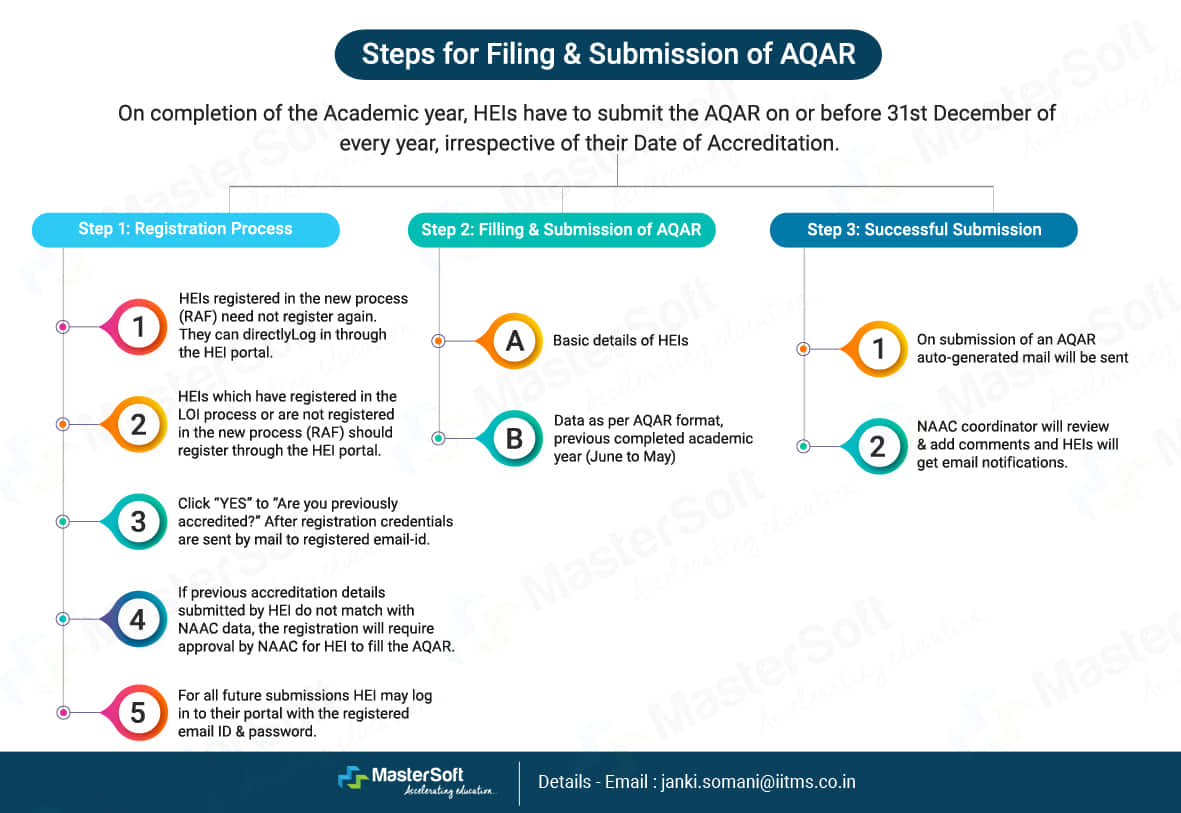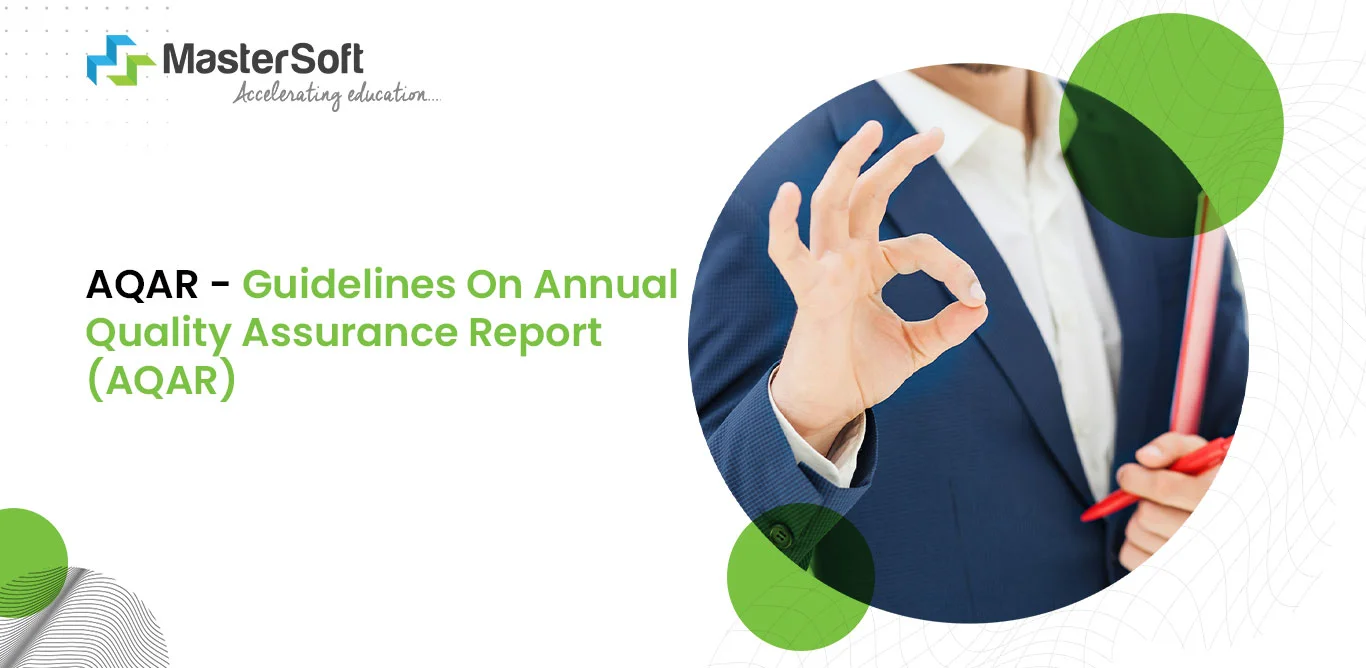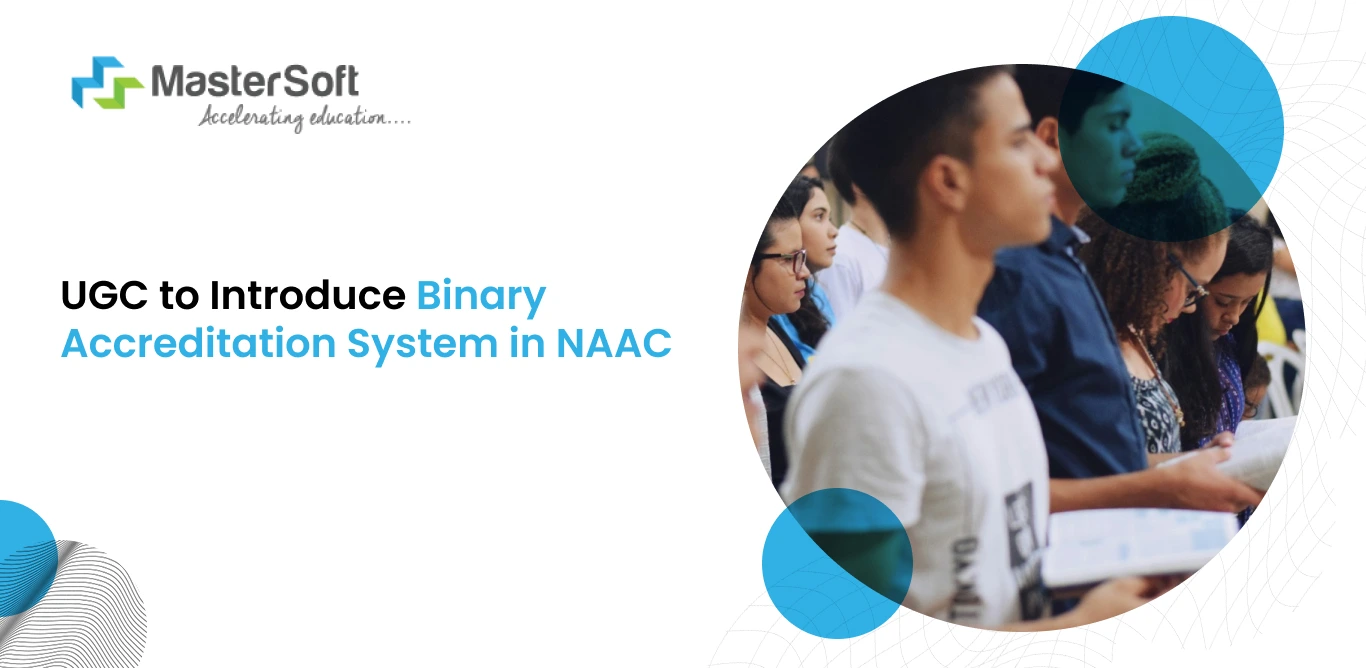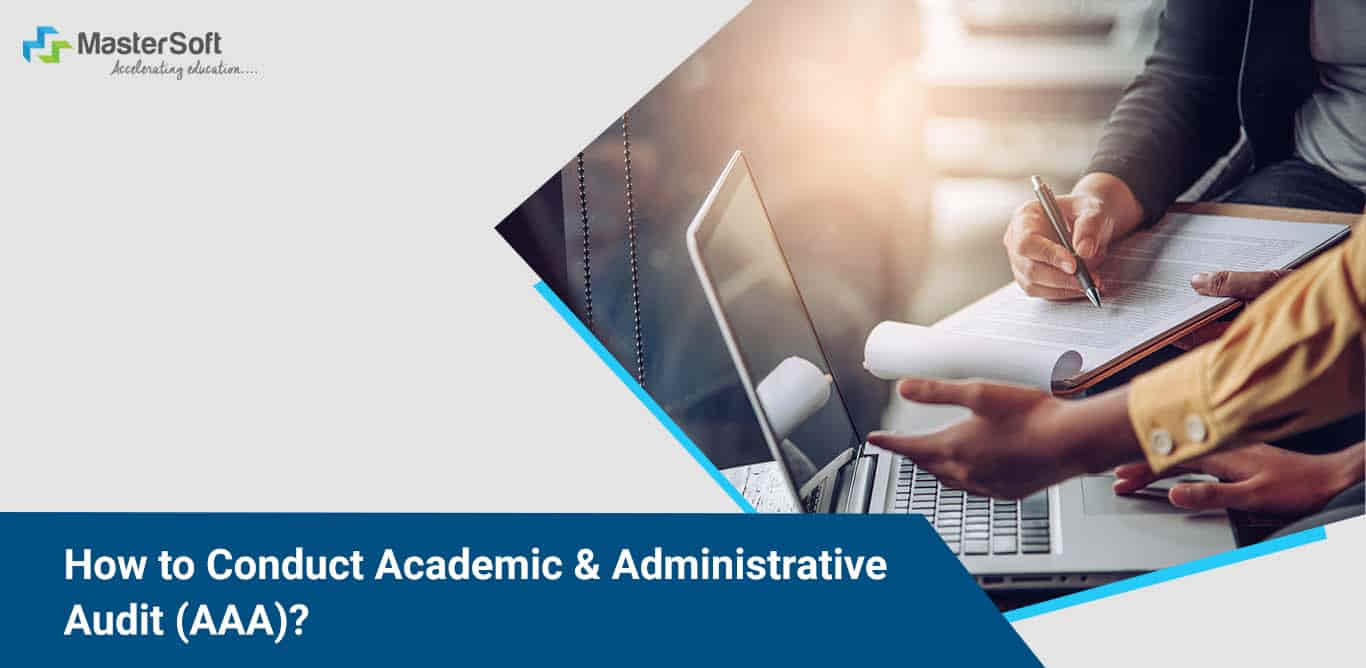Updated On | 19, November 2021
National Assessment and Accreditation Council (NAAC) is an organization that is funded by the University Grants Commission (UGC), responsible for assessing and accrediting institutions based on set standards and criteria. To ensure the maintenance of quality, NAAC has suggested every accredited institute set up IQAC, which would help the higher educational institutions to foster their overall performance.
What is Annual Quality Assurance Report (AQAR)?
Annual Quality Assurance Report (AQAR) is a mandatory report which institution required to be submitted to NAAC every year by all Accredited Institutions as per the format authorized. AQAR would be useful to know the growth of the institution after the accreditation. It is a helpful document that gives detailed information that indicates the results achieved in the crucial areas, these are recognized by the IQAC towards the beginning of the academic year.
Guidelines of IQAC and Submission of Annual Quality Assurance Report (AQAR)
First of all the general and basic information of the institution need to be mentioned which includes the following-
- Name of the Head of the institution
- Designation
- Does the institution function from its own campus
- Phone number/Alternate phone number/Mobile number
- Registered email, alternate email address, followed by the physical address of the institution
- Institutional status should be mentioned wherein the University could be
- State/Central/Deemed/Private, then the type of institution which could be
- Co-education/Men/Women
Likewise, there are other pointers asking questions about its financial status and contact information about the IQAC which should be answered accordingly.
Accreditation details need to be filled out next wherein the cycles, grade, CGPA, Year of accreditation, and Validity Period needs to be mentioned accordingly. As a part of quality assurance initiatives, the institutions should timely submit the report, they can also go for AQAR online submission.

AQAR - CRITERION 1: Curricular Aspects
- Curriculum Design and Development
- Academic Flexibility
- Curriculum Enrichment
- Feedback system
This includes the preparation of the syllabus along with the revision of the programs during the academic year. The programs and courses should be developed in such a way that it would serve to polish the skills of the students and increase the chances of their employability. The courses should not merely focus on bookish knowledge but rather enhance their overall knowledge give them exposure to other fields as well like entrepreneurship.
The new courses and programs that were introduced in the academic year; the institute willing to be flexible enough wherein it would implement new assessment strategies. Choice-based Credit System or Elective Course System applied at the university level during the academic year.
To enhance the overall curriculum the kind of courses and programs which are introduced in the year that focused on fostering transferable life skills. This also includes the number of field projects and internships conducted by the institution, followed by tallying up the number of students enrolled for the aforementioned internship or project.
Perhaps one of the key components of the AQAR report of colleges, the feedback system gives detailed and structured feedback from all the stakeholders including students, parents, teachers, alumni, and employers.
AQAR - Criterion 2: Teaching-Learning and Evaluation
- Student Enrollment and Profile
- Student - Full-time Teacher Ratio (Current Year Data)
- Teaching-Learning Process
- Teacher Profile and Quality
- Honors and Recognitions Received by Teachers
- Evaluation Process and Reforms
- Student Performance and Learning Outcomes
- Student Satisfaction Survey
As the name suggests this includes the number of students enrolled along with the name of the program, the number of seats available, and the number of applications that are received for a particular program or course.
As per the revised AQAR guidelines, the institutions must take into consideration of student diversity, this should include the number of students enrolled within the institution for both undergraduate and post-graduate degrees. Followed by the number of full-time teachers available in the institution for both undergraduate and postgraduate courses lastly, teachers who teach both courses.
This includes the number of teachers who utilize Information and Communication Technology for effective teaching with the help of the Learning Management System, E-learning Resources, etc. This should be followed by writing a detailed analysis of the Students Mentoring system that is used in the institution.
This includes the number of full-time teachers who are appointed during the year, also including the vacant positions, positions filled during the current year, and the number of faculty with Ph.D.
This mentions the year the teacher received an award as well different kinds of awards, recognition, fellowships that have been received at the national, state, and international level from the government or any other recognized bodies.
This basically includes the number of days from the end of the semester to the result declaration day, this also includes an average percentage of students’ complaints regarding the evaluation process.
Related to all the programs provided by the institute, the program outcomes, program-specific outcomes, and course outcomes should be displayed on the website of the institute. The web link should be mentioned under this option along with the program name, the number of students who appeared in the final examination, and the number of students who passed the examinations.
A document that would indicate an overall institutional performance and via a weblink the results and details should be provided.
AQAR - CRITERION 3: Research, Innovations & Extension
- Promotion of Research and Facilities
- Resource Mobilization for Research
This includes the details of the awards, fellowships that are given to the respective teachers for their research and studies during the academic year.
This includes the details of different kinds of researches conducted, funds that are sanctioned and received by various agencies, industry and other organizations.
Other important components of research activities include-
- Innovation Ecosystem
- Research Publications and Awards
- Consultancy
- Extension Activities
- Collaborations
AQAR- CRITERION 4: Infrastructure & Learning Resources
- Physical Facilities
- Maintenance of Campus Infrastructure
This includes the allocating of budgets for infrastructural facilities campus area, classrooms, laboratories, seminar halls, classrooms with LCD facilities, classrooms with Wi-Fi/ LAN Seminar halls with ICT facilities, and video center.
This also includes Library as a learning resource which includes textbooks, reference books, e-books, journals, e-journal, etc. This is followed by the technology upgrade process through the regular maintenance of the devices and institution system.
This should include an institutional website link to a 500 words piece detailing the procedures and policies followed to maintain and utilize the physical infrastructural facilities such as computers, classrooms, sports complexes, etc.
AQAR- CRITERION 5: Student Support & Progression
- Student Support
This includes various kinds of supports and assistance provided by the institution to the students.
- Scholarships and financial support provided by the institution
- Financial supports provided by other agencies
- This also includes the number of capability enhancement schemes initiated by the institution such as personal counseling, soft skills development, yoga, etc
- Names of the schemes that benefitted the students during the preparation of the Government preparation examination. Along with the number of benefited students
- Remedial measures for addressing student grievances, prevention of sexual harassment, and ragging cases during the academic year
- Student Progression
- Student Participation and Activities
This area should include the details of the campus placement during the academic year followed by the details of the students progressing into higher education. Lastly the details of students qualifying the state, national and international level examinations.
This space is particularly to be used for mentioning the number of awards and medals to the students for their excellent performance in sports and cultural activities at the national and international levels.
AQAR- CRITERION 6: Governance Leadership & Management
- Institutional Vision and Leadership
- Strategy Development and Deployment
Under this criteria, two practices of decentralization and participatory management at all levels of the operation of the institution should be mentioned within five hundred words.
The improvement strategies which the institution have adopted for the following:
Curriculum development, teaching, and learning, examination, and evaluation, Library, ICT and Physical Infrastructure / Instrumentation, Human Resource Management, Industry Interaction / Collaboration, Admission of Students, etc.
The last three components of this criterion are Faculty Empowerment strategies and financial management and resource mobilization followed by the Internal Quality Assurance system.
AQAR- CRITERION 7: Institutional Values & Best Practices
This includes the practices and policies that are implemented by the institution to maintain gender equality, environmental consciousness, and emphasize sustainable energy initiatives. This also focuses on details of differently-abled facilities such as scribes for examination, facilities for examination for ramp and rails, etc.
FAQ’s On Annual Quality Assurance Report (AQAR)
Internal Quality Assurance Cell (IQAC) is a specific committee that is required to form by every accredited institution for the maintenance of quality in the institute. IQAC plays an important role in implementing measures that would ensure smooth institutional functioning.
AQAR stands for Annual Quality Assurance Report which is a reporting document that includes a detailed analysis of all the achievements and activities performed by the institution in an academic year.
AQAR Report for colleges or higher educational institution helps to provide precise information about the institution’s growth aligned with the seven key criteria specified by NAAC. The report is useful in showcasing the initiatives and steps taken by the institute towards growth and development.
To remain updated with the AQAR format one can check the official NAAC website.
It is mandatory for all accredited institutions to submit the AQAR report because it is a part of the subsequent cycle of Accreditation.
No hard copies of the report are required to send instead the report needs to be submitted online via the official website.
No, that is not allowed, the institute is required to prepare a separate report for each year and then submit it accordingly.
How can MasterSoft Help HEIs to Prepare AQAR Report?
MasterSoft being one of the most trusted edTech companies in India provides robust solutions for integrating technology and simplifying the most tedious and time-consuming tasks.
With the help of its Accreditation Data Management Software, any institution can prepare their AQAR reports and automate the process of evaluating the student a well as the faculty performance. Besides this, the ADMS software helps HEIs to -
- Store & compile all the institutional data & supporting documents at a centralized platform
- Offers great security with highly secured cloud servers
- Generates highly accurate and ready to upload reports in the desired format
- Preserves & maintains legacy data & reports in chronological order
- Provides actionable insights via AI-powered analytics dashboard
Get a Step Ahead in Accreditation Journey with MasterSoft's Accreditation Data Management Software!
Mobile: 08448010216
Email:info@mastersofterp.com
Disclaimer
This publication, and the contents herein, introduces overall features of the Accreditation Data Management System developed and owned by the MasterSoft ERP Solutions Private Limited, however, the access to the same shall be limited to the features opted by its Users. It shall be understood that the System shall be modified from time to time by the MasterSoft ERP Solutions Private Limited as and when found necessary, and such modifications shall be made available, automatically and mandatorily, to the Users.
The Accreditation Data Management System allows the Institutes to assimilate Campus Data in one Central Database, and generates various Reports that may be helpful in the accreditation process. However, it does not calculate/estimate/speculate the accreditation or ranking scores, and it shall not be implied in any manner that we claim to improve the accreditation score or ranking of the Institutes.
MasterSoft ERP Solutions Private Limited is not associated with the NAAC, and no part of the contents published herein intend to imply the same. Any part of such contents, if found to be similar to or suggestive towards the material featured on the official Website of the NAAC, is to be treated as having been sourced from the said Website; and MasterSoft ERP Solutions Private Limited claims no ownership or interest over the said information.
We declare that every such information is published in consonance with the Copyright Policy of the NAAC as stipulated on its official Website, and that we have no intention to dilute the accuracy of or to derogate the said material. We also affirm that no part of the contents published herein infringe Copyright(s) of any third party(ies).
We urge all the readers of our publications to honour the esteem of NAAC, and the sacrosanct information published by it in public interest.













